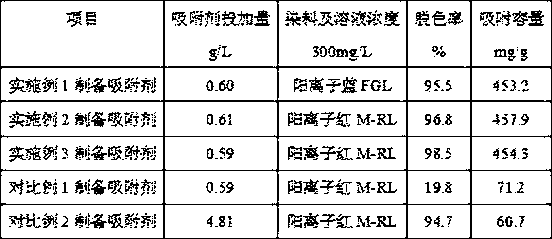High-concentration wastewater resource utilization method
A high-concentration wastewater and resource-recycling technology, applied in chemical instruments and methods, water pollutants, multi-stage water treatment, etc. Treatment cost, effect of improving adsorption capacity
- Summary
- Abstract
- Description
- Claims
- Application Information
AI Technical Summary
Problems solved by technology
Method used
Image
Examples
Embodiment 1
[0028] (1) Add strong acidic hydrogen-type cation exchange resin to high-concentration water-based ink printing wastewater, and stir the reaction to reduce the solubility of the water-soluble polymer binder and destroy the stability of the binder, so that the extractable substances in the wastewater just condense into Insoluble fine solid particles;
[0029] (2) Separating the cation exchange resin, slowly adding an appropriate amount of potassium bicarbonate powder to the wastewater, reacting with the wastewater to generate micro-bubbles, making the bubbles adhere to the fine solid particles in the wastewater, and forming gas, liquid and solid particles between the fine solid particles. Contact interface;
[0030] (3) Heating to a temperature higher than 25°C above the softening point of the binder, gradually making the fine solid particles bond to each other to form a large solid extract with tiny air bubbles and water inside;
[0031](4) Keep warm for 25 minutes, use the f...
Embodiment 2
[0037] (1) Add weakly acidic hydrogen-type cation exchange resin to high-concentration water-based ink printing wastewater, and stir the reaction to reduce the solubility of the water-soluble polymer binder and destroy the stability of the binder, so that the extractable substances in the wastewater just condense into Insoluble fine solid particles;
[0038] (2) Separating the cation exchange resin, slowly adding an appropriate amount of sodium bicarbonate powder to the wastewater, reacting with the wastewater to generate micro-bubbles, making the bubbles adhere to the fine solid particles in the wastewater, and forming gas, liquid and solid particles between the fine solid particles. Contact interface;
[0039] (3) Heating to a temperature 20°C higher than the softening point of the binder, gradually making the fine solid particles bond to each other to form a large solid extract with tiny air bubbles and water inside;
[0040] (4) Keep warm for 30 minutes, use the force suc...
Embodiment 3
[0046] (1) Add strong acidic hydrogen-type cation exchange resin to high-concentration water-based ink printing wastewater, and stir the reaction to reduce the solubility of the water-soluble polymer binder and destroy the stability of the binder, so that the extractable substances in the wastewater just condense into Insoluble fine solid particles;
[0047] (2) Separate the cation exchange resin, slowly add appropriate amount of sodium carbonate powder to the wastewater, react with the wastewater to generate micro-bubbles, make the bubbles adhere to the fine solid particles in the wastewater, and form three phases of gas, liquid and solid between the fine solid particles contact interface;
[0048] (3) Heating to a temperature 15°C higher than the softening point of the binder, gradually making the fine solid particles bond to each other to form a large solid extract with tiny air bubbles and water inside;
[0049] (4) Keep warm for 30 minutes, use the force such as the curl...
PUM
| Property | Measurement | Unit |
|---|---|---|
| adsorption capacity | aaaaa | aaaaa |
| adsorption capacity | aaaaa | aaaaa |
| adsorption capacity | aaaaa | aaaaa |
Abstract
Description
Claims
Application Information
 Login to View More
Login to View More - R&D
- Intellectual Property
- Life Sciences
- Materials
- Tech Scout
- Unparalleled Data Quality
- Higher Quality Content
- 60% Fewer Hallucinations
Browse by: Latest US Patents, China's latest patents, Technical Efficacy Thesaurus, Application Domain, Technology Topic, Popular Technical Reports.
© 2025 PatSnap. All rights reserved.Legal|Privacy policy|Modern Slavery Act Transparency Statement|Sitemap|About US| Contact US: help@patsnap.com

